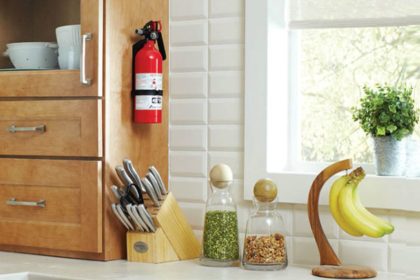
It’s easy to panic when you’re in the midst of a home emergency like gushing pipes, kitchen fires, or a leaking roof. We believe homeowners can save themselves a lot of anxiety – and even money – by taking a few simple steps to minimize the damage while they wait for an expert to help. Here’s how we suggest responding to five common home emergencies:
1. Burst Pipes and/or Flooding
Frozen pipes and flooding can be easily prevented by disconnecting all outside hoses and covering the bib with a hard faucet cover before temperatures drop below freezing. If you have a bathroom on an overhang, turn the hot and cold water on at a pencil drip during cold snaps. When warm weather arrives in the spring, turn on your garden hose and run it for 15 minutes to makes sure there is no leaking through walls or ceilings – which is an indication that a pipe has cracked. Yikes!
When a pipe bursts you should immediately turn your home’s water supply off at the main valve. Even if you have an emergency plumber on the way, allowing water to run for 30-45 minutes while you wait can cause serious damage to your home! Valves are usually located at the lowest level near the front of your home. If you’re unsure where your shut-off valve is located – now is the time to find it!
2. Leaky Roof
Typically, leaky roofs happen when shingles blow off, nails rust out, or flashing is worn. If you have water leaking through your ceiling, stop the water with a bucket and call a reliable roofing professional. It can be tempting to head to the attic or roof to evaluate the issue, but this is a huge safety issue!
One final word of wisdom about leaking roofs, while it can be tempting to hire someone who can come out immediately and “give you a good deal” on fixing your roof. We would caution you against this! Bad and cheap repairs can lead to wood rot and much larger fixes down the road! Call a reliable professional, they can provide a temporary fix to ensure things don’t get worse and get you on their project schedule.
3. Leaky Toilet
Leaky toilets create a sense of emergency since water can penetrate through the floor, but they are usually a very simple fix! Most of the time, all a leaky toilet needs is a new flapper in the inside of the tank. Simply turn the water supply at the base of your toilet off, replace the flapper, and turn the water supply back on. Replacing the flapper (and other inside components) in your toilet tank should actually be done every five years to prevent leaking toilets and keep them working their best. Who knew?!
Obviously, if your toilet is still leaking after you replace the flapper, we recommend calling a professional.
4. Unresponsive Furnace
What does tech support always say when you call them? “Have you tried turning it off and then of again?” As silly as that sounds, always start by cycling off the power of your furnace for at least five minutes and then turn it back on again. You can use the breaker or on/off switch on the furnace for this, either will work. Once you’ve done that, turn the thermostat on and see if the heat comes on. If that doesn’t work, try replacing your filter. If your furnace still won’t work, it’s time to call a qualified HVAC professional.
To keep your furnace operating smoothly, check your filters monthly and replace dirty filters as needed. We also recommend having a qualified HVAC professional out once a year to inspect and service your furnace to prevent problems and keep it in good working order.
5. Kitchen Fire
According to the National Fire Protection Agency (NFPA), kitchen fires are the leading cause of home fires and home injuries. The leading cause of kitchen fires is unattended cooking. The best thing you can do to avoid kitchen fires is keep a fire extinguisher in your kitchen and know how to use it. Other simple steps you can take is to always keep a metal lid nearby to smother small grease fires (glass lids may shatter). Never try to extinguish a grease fire with water. If you experience an oven fire the best thing you can do is turn the oven off and keep the oven door closed.
Always stay alert when frying, grilling, boiling, or broiling foods. Also check on simmering, baking, and roasting dishes regularly. Keep anything flammable away from your stove top – oven mitts, wooden utensils, food packaging, towels, curtains, etc. And heat oil slowly to reduce splatter.
Hopefully these tips leave you feeling more prepared and confident in case you ever find yourself dealing with one of these five common home emergencies!